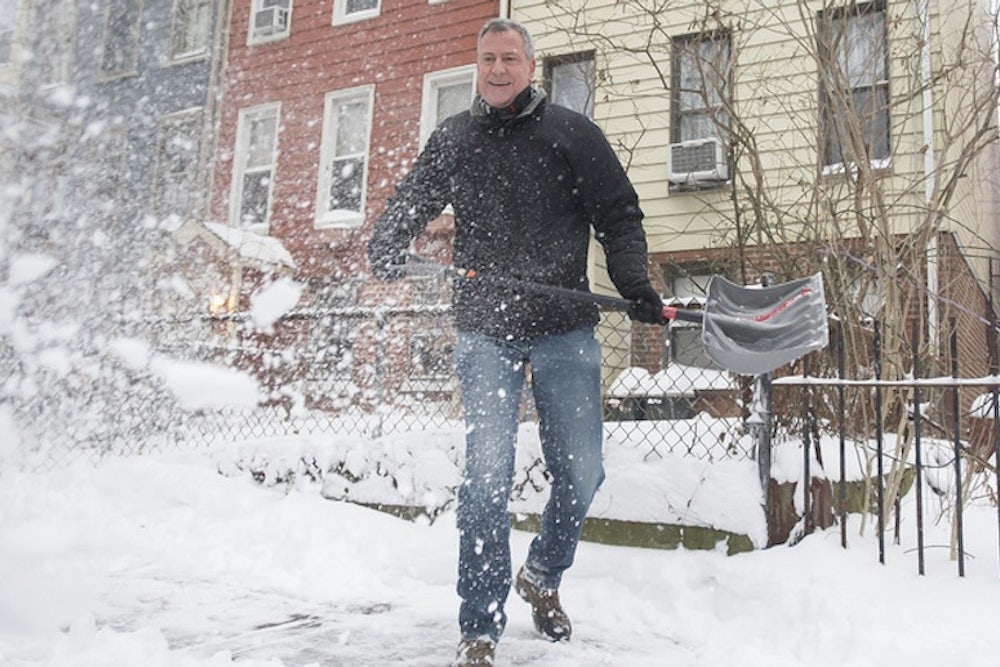Tuesday’s snowstorm and the freezing temperatures that have kept New York City on ice are proving the most daunting challenge yet to Bill de Blasio’s young tenure as mayor. His administration has been accused of not sufficiently clearing snow from Manhattan’s Upper East Side, even as other parts of the city received the necessary care and attention. On Wednesday, de Blasio acknowledged the shortcoming, saying, “After inspecting the area and listening to concerns from residents earlier today, I determined more could have been done to serve the Upper East Side.”
De Blasio faces a much more severe and complex version of an issue that bedevils all mayors. Call it the pothole problem: All the good intentions, high-minded policy proposals, and ideological kinship in the world will not satisfy citizens of a city if the day-to-day services they depend on are not functioning. And hardly anything strains those day-to-day services—and city-dwellers’ tempers—like a snowstorm.
In de Blasio’s case, the pothole problem is exacerbated by the fact that his election was seen locally as an ideological transformation: the repudiation of 20 years of non-Democratic mayors with the election of an unabashed progressive who ran on a populist platform. The notion that de Blasio was elected purely on a plank designed to appeal to writers at liberal national publications is unfair: fighting both the police department’s stop-and-frisk policy and a string of potential hospital closures—progressive stances that also resonated on a visceral level with the city’s poor and minority populations—was at least as important to his victory. But it’s a notion that has staying power.
The result is that de Blasio has a much smaller margin for error when it comes to managing bread-and-butter things like a blizzard. (Mayor Michael Bloomberg arguably had a similarly tight margin for a different reason: He was the city’s wealthiest resident. He tried to expand that margin by symbolically aligning his interests with those of most city residents, for example by sometimes riding the subway to work.)
Even de Blasio’s laudable efforts to decrease pedestrian fatalities—for which he has received plaudits from, for example, the conservative City Journal—has its perils. Police allegedly treated an 84-year-old roughly while arresting him for the not-cardinal sin of jaywalking, and all de Blasio could do was decline to comment except to defend the local precinct.
While other mayors might have received the benefit of the doubt on the snow clearance or the jaywalking—at least until outright incompetence was more definitively proven—de Blasio is liable to be immediately accused of focusing on more hifalutin subject matter at the expense of tending to essential municipal functions.
This may already be happening. The New York Post, generally nobody’s idea of an advocate for the wealthy, has been piling on de Blasio for ignoring the benighted Upper East Side (it also put the jaywalker on its cover). Dan Garodnick, a city councilman who represents some of the neighborhood and who also recently lost the speakership competition to de Blasio’s favored candidate, has been a vocal critic. And some Upper East Side residents are making the subtext explicit: One told the Journal, “We're not rich, we're not billionaires, but de Blasio is taking it out on us because no one around here voted for him.” (Thanks to a city website, which debuted last year, that displays the status of streets throughout the city, UES residents are hip to the fact that de Blasio’s Park Slope neighborhood in Brooklyn had apparently received better treatment.) The point is intelligible to anyone who lives in the five boroughs: The Upper East Side is not just a neighborhood, but a synecdoche for the rich; de Blasio is engaging in class warfare against the rich; hence, snow on the Upper East Side.
Real talk: de Blasio, in some of his policies, does favor some city residents over others. Take his “signature proposal,” a tax on the wealthiest to pay for universal pre-kindergarten and some after-school activities. It is likely intended not merely to fund those education programs, but also to transfer a little bit of wealth from the richest—the tax would only apply to those who make $500,000 or more—to the less-well-off, in this case parents of public school children, with the aim of addressing the “inequality crisis” that he cited every day of his campaign. That’s probably one reason why the mayor is not satisfied with Governor Andrew Cuomo’s recent pledge to fund universal pre-kindergarten with existing state funds. The tax is part of the point.
The de Blasio administration is almost certainly not ideologically committed and politically stupid enough to extend this wealth-transfer policy to snow removal; for that style of governance, you have to look across the Hudson River. Surely the Upper East Side’s plight, to the extent that it isn’t invented, is accidental. But this episode is a great microcosm of a prime challenge de Blasio will face as he attempts to enact a progressive agenda over the next four years. The fact that he has become a national figure for his ideological crusading makes it all the more important that the figurative and literal trains run on time. And the fact that some of his policies really do favor the vast majority of the city that isn’t very wealthy provides a convenient frame for his detractors. Besides: Everyone is cranky. It’s really, really cold, and we want our streets plowed.
